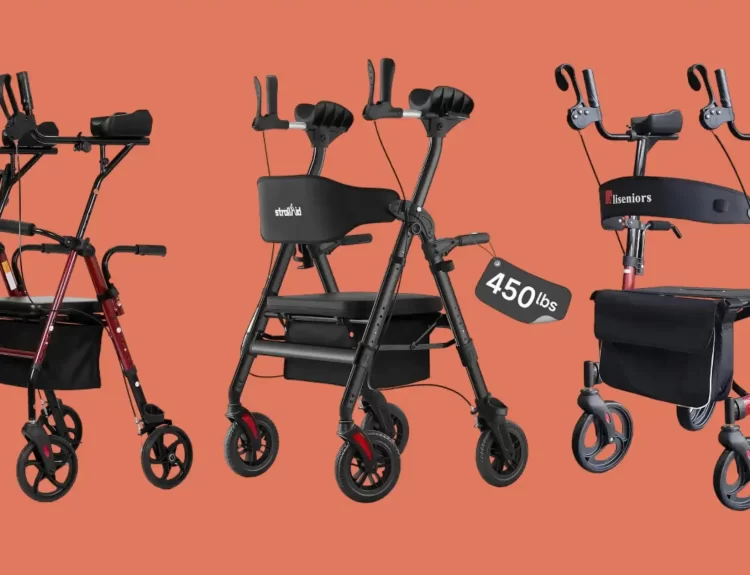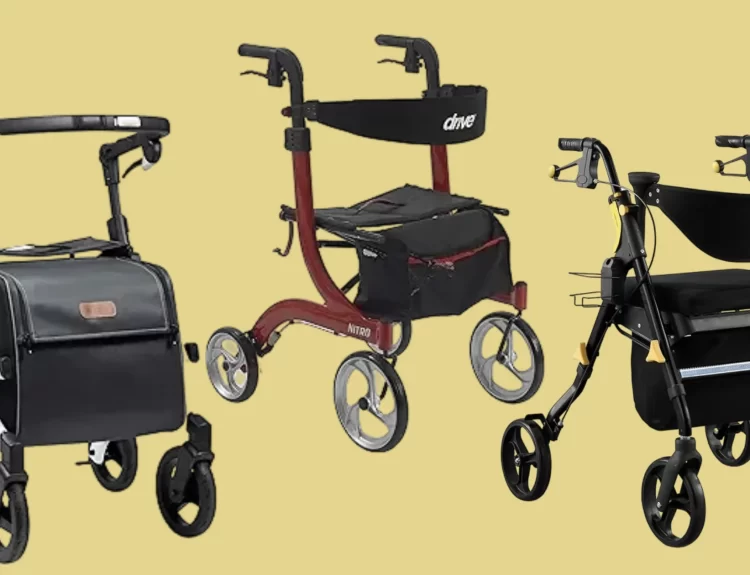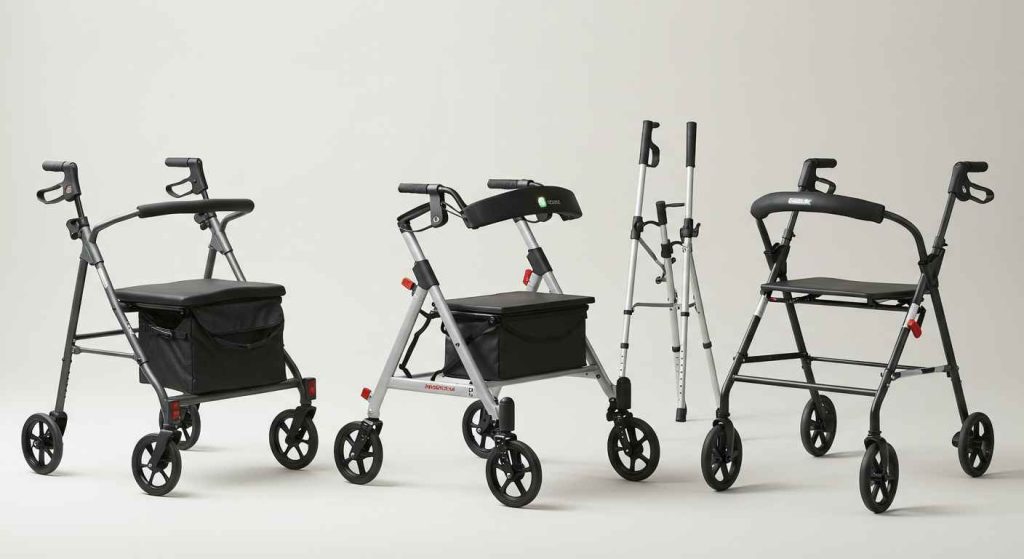
Mobility is more than just movement; it’s freedom, independence, and quality of life. For seniors, the right walker can mean the difference between confidently enjoying daily activities or feeling restricted and unsafe. But with so many options on the market, how do you know which one strikes the perfect balance between comfort and support?
This guide ranks 8 different types of walkers for seniors, carefully evaluated for stability, ease of use, and overall comfort. Each section highlights key features, pros and cons, and the best-fit recommendations so you can make an informed choice whether you’re shopping for yourself or a loved one.
Quick Overview of Different Types of Walkers for Seniors
- Standard Walker (No Wheels): Maximum stability, best for balance issues and post-surgery recovery.
- Four-Wheel Rollator with Seat: Comfort-first design with seating and storage, ideal for active seniors.
- Upright Walker (Forearm Support): Encourages proper posture and reduces strain on back and wrists.
- Two-Wheel Walker (Front Wheels): A balance of support and mobility, great for moderate assistance needs.
- Bariatric Heavy-Duty Walker: Reinforced frame built for higher weight capacity and maximum durability.
- Folding Travel Walker: Lightweight and portable, best for trips and easy storage.
- Hybrid Rollator-Transport Chair: Dual-function rollator for independence, transport chair for caregiver assistance.
- Knee Walker/Scooter: Specialized aid for non-weight-bearing recovery after leg, foot, or ankle injuries.
The 8 Different Types of Walkers for Seniors
1. Standard Walker (No Wheels)
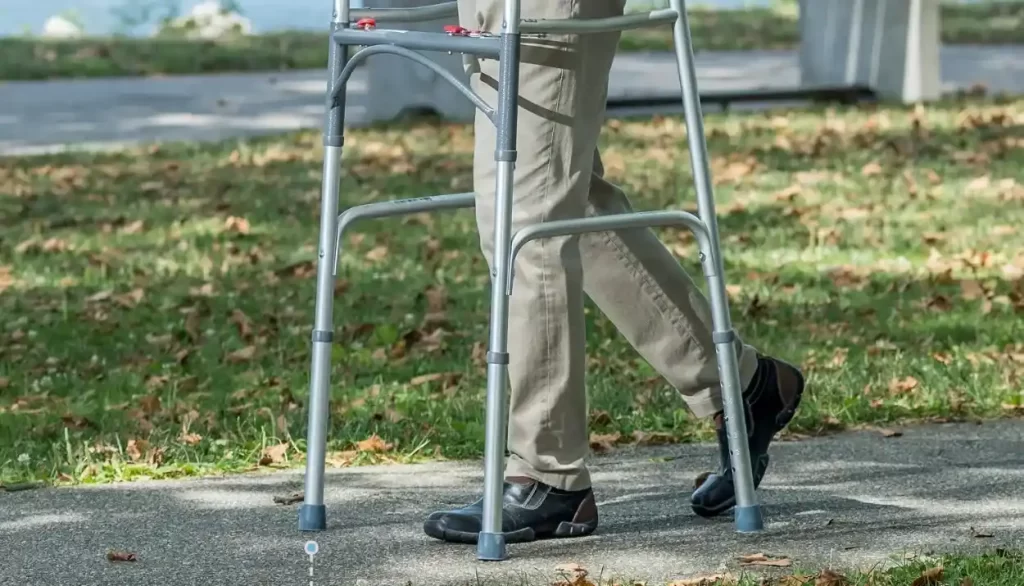
Comfort Score: 7/10 | Support Score: 10/10
The standard walker is the most traditional and widely recognized mobility aid, often recommended by doctors and physical therapists as the first line of support for seniors with significant mobility challenges. Built with four stable legs and no wheels, it requires users to lift the frame slightly with each step before moving forward. While this motion can be tiring over longer distances, it drastically reduces the risk of slipping or rolling unexpectedly.
This design makes it particularly valuable for seniors recovering from surgery such as hip or knee replacements or for those with severe balance issues, as it provides a steady anchor with every movement. Unlike wheeled options, the standard walker gives the user complete control of their pace, which can boost confidence and reduce fall anxiety. It isn’t the fastest option, but when safety and maximum stability are the priority, the standard walker remains unmatched.
Best For: Seniors with severe balance challenges, those recovering from surgery, or anyone who requires maximum weight-bearing support on a daily basis.
Key Features
- Weight capacity: 300–400 lbs
- Lightweight frame: 5–6 lbs
- Adjustable height for different user needs
- Soft, padded hand grips for added comfort
Pros
- Simple, reliable structure with no moving parts
- Lightweight and easy to maneuver indoors
- Frequently covered by Medicare and insurance
Cons
- Must be lifted with every step, which can be tiring
- Less practical for outdoor or uneven terrain
- Walking pace is slower compared to wheeled options
2. Four-Wheel Rollator with Seat

Comfort Score: 10/10 | Support Score: 8/10
The four-wheel rollator with seat is designed for seniors who want a walker that goes beyond simple mobility support to deliver comfort, convenience, and versatility. Unlike standard walkers, the rollator glides effortlessly thanks to its four smooth-rolling wheels, making it ideal for both indoor hallways and outdoor sidewalks. Its standout feature the padded seat and supportive backrest, allows seniors to stop, rest, and recharge whenever fatigue sets in, without needing to search for a chair.
This type of walker is especially popular among active older adults who enjoy shopping trips, community events, or walks in the park. The inclusion of a storage basket or bag means users can carry essentials like a purse, groceries, or even medical supplies without juggling items in their hands. While it may not offer the same level of stability as a non-wheeled walker, its ability to combine mobility assistance with independence and lifestyle freedom makes it a top choice for those prioritizing comfort and convenience.
Best For: Seniors who enjoy outdoor activities, walk longer distances, or appreciate having a built-in rest stop whenever fatigue sets in.
Key Features
- Padded seat and supportive backrest for resting
- Easy-to-use hand brakes for control and safety
- Storage basket or bag for carrying essentials
- Large wheels (6–8 inches) designed for smooth, stable movement
Pros
- Excellent performance on outdoor terrain and longer routes
- Built-in walker with seat for rest and recovery
- Storage for personal items ideal for errands and shopping
- Encourages independence and active lifestyles
Cons
- Less stable than non-wheeled walkers if brakes aren’t engaged
- Heavier than standard walkers, which can be a drawback indoors
- Requires awareness and control and may not suit those with severe balance issues
3. Upright Walker (Forearm Support)

Comfort Score: 9/10 | Support Score: 9/10
The upright walker for seniors, also known as a forearm support walker, is designed to address a common issue with traditional walkers: poor posture. Instead of forcing users to hunch over, this walker supports the forearms, encouraging an upright stance. By redistributing weight through padded armrests, it reduces strain on the wrists, shoulders, and lower back.
For seniors with chronic back pain, arthritis, or mobility challenges that make leaning down difficult, this walker can be life-changing. Studies show it can offload up to 46% of body weight through the forearm platforms, making walking less painful and more sustainable. While bulkier than standard walkers and often more expensive, the trade-off is improved alignment, reduced discomfort, and the confidence to walk longer distances without fatigue.
Best For: Seniors with back pain, posture issues, or wrist weakness who want to maintain a natural, upright walking position.
Key Features
- Padded forearm platforms that support upper body weight
- Tall, adjustable handles that promote upright walking
- Hand brakes integrated into the forearm rests
- Built-in seat and backrest for resting
Pros
- Encourages upright posture and reduces slouching
- Eases pressure on wrists, shoulders, and spine
- Supports a more natural walking pattern
- Improves balance and walking confidence
Cons
- Typically more expensive than standard or rollator walkers
- Bulkier frame may be harder to maneuver indoors
- Requires an adjustment period for first-time users
4. Two-Wheel Walker (Front Wheels)

Comfort Score: 6/10 | Support Score: 8/10
The two-wheel walker strikes a middle ground between the ultra-stable standard walker and the more mobile rollator. With small wheels on the front legs and glides on the back, it allows users to push the walker forward instead of lifting it completely off the ground, making it easier on the arms while still offering solid stability.
This walker for moderate support is a favorite for seniors who find the standard walker too physically demanding but don’t feel safe using a fully wheeled rollator. It works best on smooth indoor surfaces and short outdoor walks on flat terrain. While it doesn’t have a seat or the same level of convenience as a rollator, it remains a cost-effective, lightweight solution for those seeking balance between mobility and safety.
Best For: Seniors who need more stability than a rollator but want an option that is less tiring than a standard walker.
Key Features
- Two small front wheels with rear glide caps or tips
- No need to lift entirely with each step
- Weight capacity: typically 300–350 lbs
- Foldable frame for compact storage
Pros
- Easier movement than standard walkers
- More stable than four-wheel rollators
- Affordable compared to advanced walkers
- Lightweight and easy to fold for storage
Cons
- Less stable than walkers without wheels
- Not ideal for rough or uneven surfaces
- Lacks a built-in seat or storage option
5. Bariatric Heavy-Duty Walker

Comfort Score: 8/10 | Support Score: 10/10
A bariatric walker, sometimes called a heavy-duty walker for seniors, is specifically engineered for users who require extra strength, space, and support. Built with reinforced steel or aluminum frames, these walkers accommodate weight capacities of 400 to 700 lbs, far exceeding the limits of standard designs. They are also wider, offering greater comfort for users with broader body frames.
This walker provides the same stability as a standard model but with the durability needed for heavier use. While heavier and less portable than other types, bariatric walkers play a critical role in ensuring safety and independence for seniors who may not otherwise have a suitable mobility aid. For many, it represents not only improved mobility but also a chance to stay active and engaged in daily life.
Best For: Seniors who need higher weight capacity, have broader shoulders or body frames, or require maximum strength and durability in their mobility aid.
Key Features
- Reinforced frame built for durability
- Weight capacity of 400–700 lbs
- Wider design for extra comfort and space
- Available in both wheeled and non-wheeled versions
Pros
- Exceptional support and strength capacity
- Wider frame offers added comfort
- Reliable stability, even under heavier loads
- Helps maintain independence for users who may otherwise lack suitable options
Cons
- Heavier and more difficult to transport
- Bulkier design limits portability
- Higher cost compared to standard walkers
6. Folding Travel Walker

Comfort Score: 6/10 | Support Score: 7/10
The folding travel walker is built with one priority in mind: portability. Unlike heavier or bulkier designs, this lightweight walker folds down quickly, making it easy to slip into a car trunk, overhead compartment, or suitcase. It sacrifices some of the bells and whistles (like seats or storage baskets) in favor of a compact, minimalist frame that can go virtually anywhere.
For frequent travelers, snowbirds, or seniors who like to stay active while visiting family, the folding travel walker is a game-changer. While not as sturdy as a standard or bariatric walker, it still provides a reliable base of support for those who need moderate balance assistance but value freedom of movement and easy storage.
Best For: Seniors who travel frequently, need a backup mobility aid for outings, or prioritize lightweight convenience over heavy-duty support.
Key Features
- Ultra-lightweight aluminum frame (often under 5 lbs)
- Folds flat for storage or travel
- Adjustable height for different users
- Some models come with optional front wheels for easier rolling.
Pros
- Extremely portable and easy to carry
- Quick-fold design for cars, planes, or small spaces
- Affordable compared to advanced walkers
- Great as a secondary walker for trips and outings
Cons
- Less stable than standard or bariatric walkers
- Minimal features (no seat, limited storage)
- Best suited for short-term or light use
7. Hybrid Rollator-Transport Chair
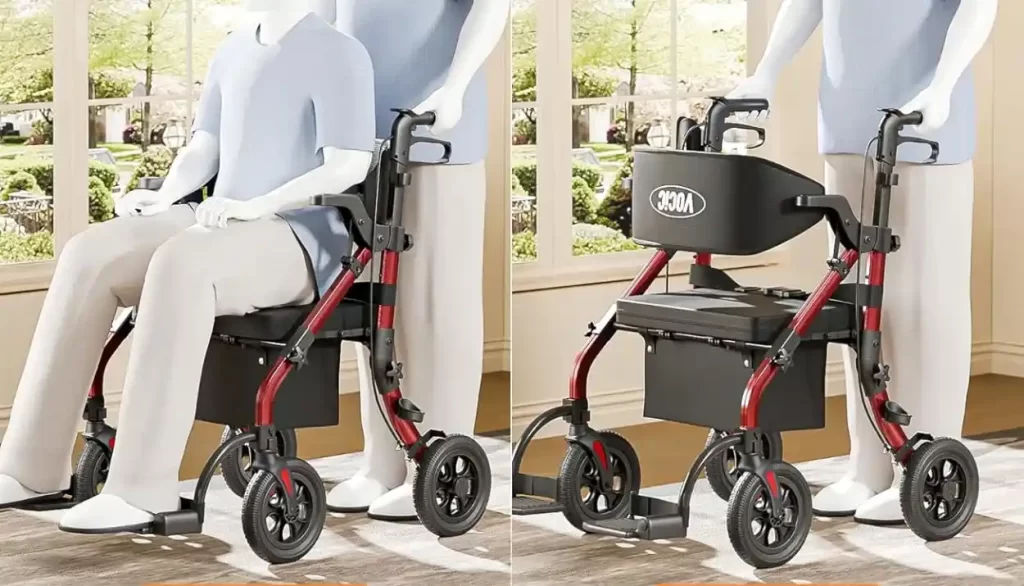
Comfort Score: 9/10 | Support Score: 8/10
The hybrid rollator transport chair is a two-in-one solution that functions both as a walker and a wheelchair. Seniors can walk independently using it as a rollator, and when fatigue sets in, a caregiver can flip down the footrests and push it like a transport chair. This makes it one of the most versatile mobility aids on the market, especially for those who want independence but also need occasional assistance.
For families and caregivers, this design reduces the need to purchase both a walker and a wheelchair. It’s particularly helpful during long outings, medical appointments, or vacations where walking long distances isn’t always possible. Though heavier and bulkier than standard rollators, its adaptability makes it the best walker for seniors with caregivers who want flexible mobility support.
Best For: Seniors who want independence most of the time but may occasionally need a caregiver’s assistance for longer distances.
Key Features
- Dual function: walker + transport chair
- Locking hand brakes for safety
- Padded seat and flip-down footrests
- Strong frame with higher weight capacity than standard rollators
Pros
- Combines two mobility aids in one device
- Built-in seat and transport-chair function
- Saves money compared to buying a walker and wheelchair separately
- Ideal for long outings or travel with family
Cons
- Heavier and less compact than regular rollators
- Requires a caregiver to use transport chair mode
- Bulkier to store or transport
8. Knee Walker/Scooter

Comfort Score: 7/10 | Support Score: 6/10 (specialized use only)
A knee walker, also called a knee scooter for seniors, is a specialized mobility aid designed for temporary injuries rather than long-term support. Instead of bearing weight on a healing foot, ankle, or lower leg, the user rests the injured limb on a padded knee platform while propelling forward with the other leg. Four wheels and handlebars provide steering, while hand brakes add safety and control.
This is not a replacement for a standard walker or rollator; it’s a short-term mobility solution most commonly prescribed after surgery or fractures. Seniors who struggle with crutches often find a knee walker easier and more comfortable to use, since it reduces strain on the arms and upper body. While it’s not suited for those with general balance issues or long-term mobility challenges, it’s one of the best aids for non-weight-bearing recovery.
Best For: Seniors recovering from foot, ankle, or leg surgery who need a non-weight-bearing mobility solution.
Key Features
- Padded knee rest platform
- Handlebars with integrated brakes
- Four wheels for smooth rolling and stability
- Adjustable height for customized fit
Pros
- More stable and comfortable than crutches
- Allows faster mobility during injury recovery
- Easy steering and braking for safety
- Adjustable for different heights and body types
Cons
- Limited to short-term, injury-specific use
- Not suitable for seniors with balance issues
- Can be bulky for small indoor spaces
Choosing the Right Walker: Key Considerations
Selecting the right walker goes beyond comfort and features. It’s about aligning the device with a senior’s medical needs, environment, and lifestyle. Here are the top factors to weigh before making a decision:
Medical Needs
Always begin with medical guidance. A doctor or physical therapist can determine whether a senior requires weight-bearing support, post-surgical recovery assistance, or a device focused on posture correction. For example, those with significant balance issues may benefit most from a maximum stability walker, while others recovering from foot or ankle surgery might temporarily need a knee scooter.
Environment
Consider where the walker will be used most often. Indoor users may prefer lightweight or two-wheel walkers that fit through narrow hallways, while outdoor walkers may require large wheels, brakes, and a seat for rest breaks making a rollator or hybrid transport chair the smarter choice.
Physical Capacity
A senior’s strength, balance, and endurance should guide the decision. Those with weaker upper body strength might struggle with standard walkers that require lifting, while active seniors may find a four-wheel rollator encourages independence and longer outings.
Lifestyle Fit
Is the user homebound and focused on safety, or still active and social? Lifestyle plays a major role in selecting the right walker. Travel-friendly walkers work well for frequent flyers, while heavy-duty bariatric walkers ensure daily reliability for seniors needing extra strength and stability.
Conclusion
Choosing the right walker is more than a purchase; it’s a decision that directly affects a senior’s safety, independence, and quality of life. From the rock-solid support of a standard walker to the freedom of a four-wheel rollator or the versatility of a hybrid transport chair, there’s a model designed for every need and lifestyle.
The best first step? Consult a healthcare provider or physical therapist to ensure the walker aligns with medical requirements. With professional input and the guidance in this article, seniors and families can feel confident selecting a walker that promotes both mobility and peace of mind.
Frequently Asked Questions
What type of walker provides the most stability for seniors?
A standard walker without wheels is the most stable option, making it the best walker for seniors with balance issues or those recovering from surgery.
What is the difference between a rollator and a walker?
A traditional walker has four legs (with or without wheels) and must be lifted, while a rollator has four wheels, brakes, and often a seat, making it easier to move but slightly less stable.
Does Medicare cover the cost of walkers for seniors?
Medicare Part B typically covers standard and two-wheel walkers prescribed as medically necessary. Advanced models like upright walkers or hybrid transport chairs may not be fully covered.
Which walker is best for active seniors?
A four-wheel rollator with a seat is ideal for active seniors who enjoy walking longer distances, shopping, or outdoor activities.
What walker is best for travel?
The folding travel walker is lightweight, compact, and designed for portability, perfect for seniors who travel frequently or need a backup mobility aid.


